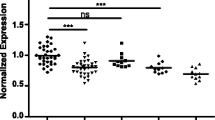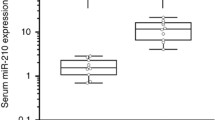Abstract
Glioma is one of the most common primary central nervous system tumors with high mortality and poor 5-year survival rate. Current diagnostic methods for glioma were either invasive or expensive. MicroRNAs (miRNAs) are small non-coding RNAs which play an important part in the regulation of gene expression. Considering the fact that miRNAs are stable in serum, plasma, urine, and other body fluids, they show great promises to be convenient and non-invasive biomarkers for cancers. This study aimed at evaluating the availability of serum microRNA-29 (miR-29) family in screening of glioma. A meta-analysis was also performed to assess the predictive value of miR-29 family in multi-cancer screening. Serum samples were collected from 83 glioma patients at different stages and 69 healthy controls. RNA was extracted and the relative expression of serum miR-29 was acquired by qRT-PCR and calculated by Cycle threshold (Ct) with microRNA-24 as an internal control. In the meta-analysis, studies concerning the predictive value of miR-29 family in cancer were retrieved. The predictive value of serum miR-29 family for glioma was moderate (AUC = 0.74). But the predictive value of serum miR-29 family in high-graded glioma detection was sufficient (AUC = 0.81). Also, serum miR-29 family might not be applicable in early-stage glioma detection (AUC = 0.66). A high predictive value of miR-29 family in multi-cancer detection was observed from meta-analysis (AUC = 0.83). This study manifested that serum miR-29 family could be applied as a biomarker for high-graded glioma screening, but the sensitivity and specificity for low-graded glioma detection might not be sufficient. A meta-analysis concerning the predictive value of miR-29 family in multi-cancer detection concluded that miR-29 family might be a sufficient universal biomarker for cancer.




Similar content being viewed by others
References
Gravendeel LA, Kloosterhof NK, Bralten LB, van Marion R, Dubbink HJ, Dinjens W, Bleeker FE, Hoogenraad CC, Michiels E, Kros JM, van den Bent M, Smitt PA, French PJ (2010) Segregation of non-p.R132H mutations in IDH1 in distinct molecular subtypes of glioma. Hum Mutat 31(3):E1186–E1199. doi:10.1002/humu.21201
Verhaak RG, Hoadley KA, Purdom E, Wang V, Qi Y, Wilkerson MD, Miller CR, Ding L, Golub T, Mesirov JP, Alexe G, Lawrence M, O’Kelly M, Tamayo P, Weir BA, Gabriel S, Winckler W, Gupta S, Jakkula L, Feiler HS, Hodgson JG, James CD, Sarkaria JN, Brennan C, Kahn A, Spellman PT, Wilson RK, Speed TP, Gray JW, Meyerson M, Getz G, Perou CM, Hayes DN (2010) Integrated genomic analysis identifies clinically relevant subtypes of glioblastoma characterized by abnormalities in PDGFRA, IDH1, EGFR, and NF1. Cancer Cell 17(1):98–110. doi:10.1016/j.ccr.2009.12.020
Schwartzbaum JA, Fisher JL, Aldape KD, Wrensch M (2006) Epidemiology and molecular pathology of glioma. Nat Clin Pract Neurol 2(9):494–503. doi:10.1038/ncpneuro0289, quiz 491 p following 516
Fan Z, Wu Y, Shen J, Zhan R (2013) Glutathione S-transferase M1, T1, and P1 polymorphisms and risk of glioma: a meta-analysis. Mol Biol Rep 40(2):1641–1650. doi:10.1007/s11033-012-2213-8
Nie S, Chen T, Yang X, Huai P, Lu M (2014) Association of Helicobacter pylori infection with esophageal adenocarcinoma and squamous cell carcinoma: a meta-analysis. Dis Esophagus : Off J Int Soc Dis Esophagus / ISDE. doi:10.1111/dote.12194
Reddy SP, Britto R, Vinnakota K, Aparna H, Sreepathi HK, Thota B, Kumari A, Shilpa BM, Vrinda M, Umesh S, Samuel C, Shetty M, Tandon A, Pandey P, Hegde S, Hegde AS, Balasubramaniam A, Chandramouli BA, Santosh V, Kondaiah P, Somasundaram K, Rao MR (2008) Novel glioblastoma markers with diagnostic and prognostic value identified through transcriptome analysis. Clin Cancer Res: Off J Am Assoc Cancer Res 14(10):2978–2987. doi:10.1158/1078-0432.CCR-07-4821
Nikiforova MN, Hamilton RL (2011) Molecular diagnostics of gliomas. Arch Pathol Lab Med 135(5):558–568. doi:10.1043/2010-0649-RAIR.1
McNamara MG, Sahebjam S, Mason WP (2013) Emerging biomarkers in glioblastoma. Cancer 5(3):1103–1119. doi:10.3390/cancers5031103
Meister G (2007) MiRNAs get an early start on translational silencing. Cell 131(1):25–28. doi:10.1016/j.cell.2007.09.021
Zen K, Zhang CY (2012) Circulating microRNAs: a novel class of biomarkers to diagnose and monitor human cancers. Med Res Rev 32(2):326–348. doi:10.1002/med.20215
Lu J, Getz G, Miska EA, Alvarez-Saavedra E, Lamb J, Peck D, Sweet-Cordero A, Ebert BL, Mak RH, Ferrando AA, Downing JR, Jacks T, Horvitz HR, Golub TR (2005) MicroRNA expression profiles classify human cancers. Nature 435(7043):834–838. doi:10.1038/nature03702
Huang Z, Huang D, Ni S, Peng Z, Sheng W, Du X (2010) Plasma microRNAs are promising novel biomarkers for early detection of colorectal cancer. Int J Cancer J Int Cancer 127(1):118–126. doi:10.1002/ijc.25007
Wang F, Wang XS, Yang GH, Zhai PF, Xiao Z, Xia LY, Chen LR, Wang Y, Wang XZ, Bi LX, Liu N, Yu Y, Gao D, Huang BT, Wang J, Zhou DB, Gong JN, Zhao HL, Bi XH, Yu J, Zhang JW (2012) miR-29a and miR-142-3p downregulation and diagnostic implication in human acute myeloid leukemia. Mol Biol Rep 39(3):2713–2722. doi:10.1007/s11033-011-1026-5
International ethical guidelines for biomedical research involving human subjects (2002) Bulletin of medical ethics 182:17–23
Sobin LH, Fleming ID (1997) TNM classification of malignant tumors, fifth edition (1997). Union internationale contre le cancer and the American joint committee on cancer. Cancer 80(9):1803–1804
Huedo-Medina TB, Sanchez-Meca J, Marin-Martinez F, Botella J (2006) Assessing heterogeneity in meta-analysis: Q statistic or I2 index? Psychol Methods 11(2):193–206. doi:10.1037/1082-989X.11.2.193
Deeks JJ, Macaskill P, Irwig L (2005) The performance of tests of publication bias and other sample size effects in systematic reviews of diagnostic test accuracy was assessed. J Clin Epidemiol 58(9):882–893. doi:10.1016/j.jclinepi.2005.01.016
Fang C, Zhu DX, Dong HJ, Zhou ZJ, Wang YH, Liu L, Fan L, Miao KR, Liu P, Xu W, Li JY (2012) Serum microRNAs are promising novel biomarkers for diffuse large B cell lymphoma. Ann Hematol 91(4):553–559. doi:10.1007/s00277-011-1350-9
Maclellan SA, Lawson J, Baik J, Guillaud M, Poh CF, Garnis C (2012) Differential expression of miRNAs in the serum of patients with high-risk oral lesions. Cancer Med 1(2):268–274. doi:10.1002/cam4.17
Zhao M, Shen XK, Zhan P, Lv CF, Liu HB, Song Y (2012) Expression of miRNA-29a in non-small cell lung cancer and clinical significance. Chin Clin Oncol 17(05):428–432
Zhu HT, Dong QZ, Sheng YY, Wei JW, Wang G, Zhou HJ, Ren N, Jia HL, Ye QH, Qin LX (2012) MicroRNA-29a-5p is a novel predictor for early recurrence of hepatitis B virus-related hepatocellular carcinoma after surgical resection. PLoS One 7(12):e52393. doi:10.1371/journal.pone.0052393
Luo X, Stock C, Burwinkel B, Brenner H (2013) Identification and evaluation of plasma microRNAs for early detection of colorectal cancer. PLoS One 8(5):e62880. doi:10.1371/journal.pone.0062880
Sevcikova S, Kubiczkova L, Sedlarikova L, Slaby O, Hajek R (2013) Serum miR-29a as a marker of multiple myeloma. Leuk Lymphoma 54(1):189–191. doi:10.3109/10428194.2012.704030
Zheng JJ, Yu FJ, Dong PH, Bai YH, Chen BC (2013) Expression of miRNA-29b and its clinical significances in primary hepatic carcinoma. Zhonghua Yi Xue Za Zhi 93(12):888–891
Hormigo A, Gu B, Karimi S, Riedel E, Panageas KS, Edgar MA, Tanwar MK, Rao JS, Fleisher M, DeAngelis LM, Holland EC (2006) YKL-40 and matrix metalloproteinase-9 as potential serum biomarkers for patients with high-grade gliomas. Clin Cancer Res : Off J Am Assoc Cancer Res 12(19):5698–5704. doi:10.1158/1078-0432.CCR-06-0181
Fabbri M, Garzon R, Cimmino A, Liu Z, Zanesi N, Callegari E, Liu S, Alder H, Costinean S, Fernandez-Cymering C, Volinia S, Guler G, Morrison CD, Chan KK, Marcucci G, Calin GA, Huebner K, Croce CM (2007) MicroRNA-29 family reverts aberrant methylation in lung cancer by targeting DNA methyltransferases 3A and 3B. Proc Natl Acad Sci U S A 104(40):15805–15810. doi:10.1073/pnas.0707628104
Pekarsky Y, Santanam U, Cimmino A, Palamarchuk A, Efanov A, Maximov V, Volinia S, Alder H, Liu CG, Rassenti L, Calin GA, Hagan JP, Kipps T, Croce CM (2006) Tcl1 expression in chronic lymphocytic leukemia is regulated by miR-29 and miR-181. Cancer Res 66(24):11590–11593. doi:10.1158/0008-5472.CAN-06-3613
Cho WC (2007) OncomiRs: the discovery and progress of microRNAs in cancers. Mol Cancer 6:60. doi:10.1186/1476-4598-6-60
Acknowledgments
This work was supported by the National Natural Science Foundation of China, no. NSFC30801417; Natural Science Foundation of Jiangsu Province, nos. BK20141324 and BK2008267; Doctoral Fund of Ministry of Education of China, no. RFDP200802841004; and Medical Science and Technology Development Foundation, Nanjing Department of Health (no. ZKX12011).
Conflicts of Interest
The authors have declared no conflicts of interest.
Author information
Authors and Affiliations
Corresponding author
Rights and permissions
About this article
Cite this article
Wu, J., Li, L. & Jiang, C. Identification and Evaluation of Serum MicroRNA-29 Family for Glioma Screening. Mol Neurobiol 52, 1540–1546 (2015). https://doi.org/10.1007/s12035-014-8937-9
Received:
Accepted:
Published:
Issue Date:
DOI: https://doi.org/10.1007/s12035-014-8937-9




